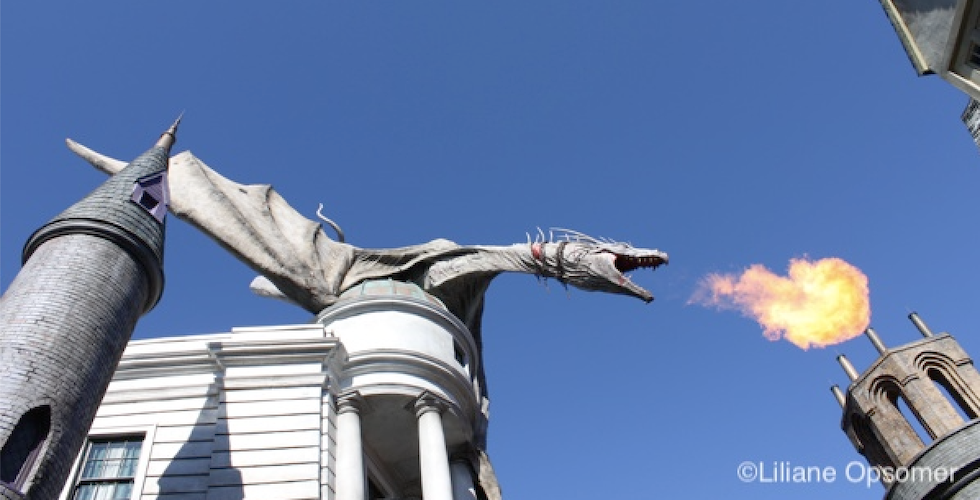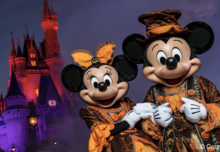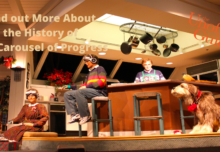Bob Sehlinger, coauthor of The Unofficial Guide to Walt Disney World and founder of The Unofficial Guides Series, in a series of two articles, takes us on a tour of the world of theme-park rides. Today’s installment is about the evolution of non-coaster thrill rides.

Though Disney changed the vernacular to “attractions” and “adventures,” we’re really talking about rides. They are the heart and essence of every theme park, and knowing a little bit about them not only enhances your enjoyment and appreciation of them, but it can also help you avoid long waits in queues. Simple rides going in circles, dating back many hundreds of years, were the progenitors of just about every modern theme-park ride. Though I’ll touch upon the evolution of all rides, our focus will be on those types of rides, usually thrill rides and roller coasters, that people travel miles to experience. And for most rides, it all started with the wheel.
Wheels within Wheels: The Evolution of Non-Coaster Thrill Rides
Though the known history of amusement rides dates to ancient Byzantium, where children were spun around a post in woven baskets, the evolution of most rides we know today began with a sixteenth-century tournament game in which competitors on horseback tried to catch a small brass ring on the tip of each other’s lances. The popularity of this endeavor occasioned the invention of a rotating platform on which a wooden version of a gymnast’s vaulting horse was mounted. With this device and a ring suspended from a nearby tree, contestants could practice their aim. Observing this activity, craftsmen fashioned a facsimile for the amusement of their children. These became very popular at fairs, attracting the attention of skilled sculptors and artists who transformed the legless and headless horses into the magnificent, colorfully painted and realistic ponies that have made the carousel a work of art.

As beloved as the carousel is, it wasn’t the horses but rather the revolving round platform that was the ancestor of most theme park rides we enjoy today. It started with a wheel rotating around a central axis. What else can be done with that? If you move the wheel from shin-level to 20 feet above the ground and suspend swings from it, you create a flying carouselor, a new ride genre simply called swings. Back on the ground, let’s cut the platform into equal pie-shaped segments and hinge them together so they can go up and down over little humps as the platform revolves. Tack on independently rotating teacup-shaped compartments to accommodate the riders, and you’ve just invented the classic Tilt-A-Whirl.

But why be satisfied with tacking various teacups, horses, and boats to a platform? What if, instead, we ditch the platform altogether and attach whatever we want—rockets, flying elephants, little helicopters—to the end of spokes emanating from a central hub? The spokes free us from the limitations of the platform and also allow us to move our rockets up and down as well as round and round. A bigger motor lets us go faster and faster until we’re screaming and holding on for dear life instead of lazily waving to mom and dad. Next, we mount the whole contraption (ride vehicles at the end of spokes revolving around a central hub) onto a hydraulic lift-arm that rises off the ground like a guided-missile launcher lifting a weapon into launch position. Now we’re cooking! With the addition of each element, we create a new axis of motion. In the process the ride moves from a horizontal plane to a vertical one and then back to the horizontal before stopping. Throw in some speed, and the modern thrill ride is born.

OK, let’s go back to basics. The business end of most thrill rides is something rotating around a central axis. The rotating somethings are what you ride in. The generic name for them is ride vehicle, though on a particular ride they can be teacups, rockets, flying hippos, gondolas, or most anything fashioned with seats. These are attached by spokes to a central hub, which in turn is attached to an axle. The spokes can radiate out from the hub directly to each ride vehicle, or they can extend outward from the top of the ride like helicopter rotor blades. In the latter case the ride vehicle, or sometimes a pod (a cluster of two to four ride vehicles), is suspended from the overhead spokes or radial support arms.
You can create a surprising number of different rides by varying the position of the hub. If the hub is vertical, the spokes emanate horizontally as in Disney’s Dumbo ride. If the hub is horizontal, the spokes project vertically, as on a Ferris wheel. As discussed earlier, you can change the position of the hub mid-ride from horizontal to vertical by elevating the ride with a hydraulic lift-arm. If you want to make the ride more intense, add additional height and speed.

Within the amusement industry, these non-coaster thrill rides that rotate around an axis are generally referred to as “flat rides,” even though they may elevate riders high above the ground. Informally, they are also called “spin-and-puke” rides for the effect they are known to have on passengers. In the ride-manufacturing business, specific types of rides commonly take the name of the first or most successful such ride introduced. Thus, the ride with the hydraulic lift-arm is known as an Enterprise, irrespective of what the ride might be called at a given park. This method of naming and defining rides is confusing and rarely consistent from country to country. To simplify, we’ve categorized rides based on their engineering design.
Platform Rides
These are carousels, Tilt-A-Whirls, teacup rides, and any other ride in which the ride vehicles are mounted on a revolving platform, usually at or near ground level. Of course, as in the case of the carousel and many children’s rides, not all platform rides are thrill rides.

Note: In the amusement industry, platform rides is also used to denote portable rides that can be transported from fair to fair. In this case platform refers to the ride’s support base as opposed to a revolving platform that is part of the ride experience.
Vertical-Hub Radial Rides
These are rides in which the hub and axle are vertical and ride vehicles are attached to spokes or steel arms radiating horizontally from the hub. Ride vehicles spin around the hub and, depending on the specific ride, may also go up and down. Examples include most revolving children’s rides where the ride vehicles are not attached to a platform, as in Disney’s Dumbo ride.

Vertical-Hub Suspended Rides
This refers to rides in which the hub and axle are vertical and the spokes or support arms extend horizontally from the top of the ride. Ride vehicles (or vehicle pods) are suspended from the overhead supports. In the case of pods, each pod is attached to the horizontal support arm by a vertical arm that allows the pod additional freedom of rotation, thus maximizing the effect of centrifugal force. These rides are variously called Twist, Sizzler, Scrambler, Cyclone, Merry Mixer, and Grasscutter, among others. In many versions, the pods are spun in one direction while the ride as a whole revolves in the opposite direction. Vertical-hub suspended rides also include swing rides, in which individual swings or ride vehicles (such as rockets) are suspended from overhead supports by chains. The Golden Zephyr and Silly Symphony rides at Disney’s California Adventure are representative of swing rides.

Hydraulic-Lift-Arm Rides
In this category of rides a hydraulic lift-arm can alter the position of the hub and axle from vertical to horizontal. The Enterprise ride described previously falls into this category.
High-Mount Horizontal-Axle Rides
Within this classification there are two basic ride types: wheel rides and pendulum rides. A wheel ride for our purposes is a Ferris wheel or a close derivative. Pendulum rides are an evolutionary mutation of wheel rides. To understand both, let’s start with the Ferris wheel. The Ferris wheel consists of a support tower and a wheel. The wheel revolves around an axle-and-hub assembly positioned horizontally at the top of the support tower. Now, just as in changing a car tire, let’s remove the wheel. What we have left are a tall support tower and a horizontal axle. This tower–axle combo serves as the essential cornerstone for dozens of pendulum ride designs. In the UK, more thrill rides fall into this category than any other, save roller coasters.

Pendulum Rides
These are rides modeled on the motion of a fixed pendulum, defined as a weight suspended from a pivot so it can swing freely. In the case of pendulum thrill rides, the ride vehicle is attached to the end of an arm (or arms) that in turn is attached to the axle. A motor powers the axle and lifts the vehicle, usually a gondola or boat-shaped carriage, from the loading platform up to a starting position. From here the brakes are released and the gondola or whatever swings to and fro. How high the gondola swings to either side isn’t left to gravity, as with a true pendulum, but is controlled by the motor (actually a series of motors), so the gondola can swing much higher than gravity would allow. The oldest and most ubiquitous example of this type of pendulum ride is known universally as the Pirate Ship. Pirate Ships come in mini-sizes for smaller kids and giant versions with 40-plus-person gondolas for older patrons.

With another variation on pendulum rides, the end of the arm is connected to a disc-shaped ride vehicle seating 30 or more riders. As the pendulum arm swings back and forth, the disc rotates independently. These rides are usually called Frisbees. Some models substitute pods or clusters of pods for the disc, and many models make complete revolutions around the axle, resulting in an inversion with each rotation. On one of the more-imaginative pendulum rides, the ride gondola makes complete inversions over a pool of spurting fountains, ultimately braking to an upside-down stop over the fountains, whereupon riders receive a free hair rinse (bring your own shampoo). At Cedar Point in Ohio, for example, the Frisbee-type ride is called maXair. When it comes to rides as spectator sport, you can’t top these.
On some pendulum rides the horizontal axle is positioned in the middle of the arm, similar to the way an airplane propeller is mounted. On one end of the arm is the ride vehicle, while the other is usually fitted with a heavy counterweight. Sometimes there are ride vehicles at both ends of the arm. Support towers for this design are quite tall, with the horizontal axle positioned as high as 60 feet (18 m) or more. At the top of the rotation, ride vehicles commonly reach heights of 120 feet (36 m). The entire ride experience consists of steep dives and climbs, and, of course, the ride vehicle is designed to rotate at the end of the arm, so there are plenty of inversions.
With varied axle heights, multiple support arm designs, dozens of ride vehicle options, modern robotics, and programmable operating systems, ride manufacturers stay busy cooking up new pendulum rides. Like the ones already in service, the new rides will look different and do different things, but each design will begin with a support tower and a horizontal axle. Pendulum rides, with an exception or two, are not favored by Disney and Universal parks because they load slowly and can accommodate a small number of riders per hour.
Other Non-Coaster Thrill Rides
There are many thrill rides besides coasters and spinning-hub-and-axle flat rides. Most prevalent are the following:
Tower Rides

Also known as drop towers, these rides are square towers measuring about 12 x 12 feet square at the base and rising as high as 415 feet. Riders are arrayed 4–8 persons to a side. Some towers are round, in which case a circular ride vehicle surrounds the tower. Most modern towers use pneumatic power to propel riders skyward to the top of the tower. From here they free-fall back to the base, with brakes governing their rate of descent and breaking the fall. Some models also use air blasts to propel the rides downward, momentarily surpassing the speed of a free fall. Though the customary ride cycle is to ascend and descend once, with a bit of bouncing on the downward leg, some rides repeat the process or haul the riders aloft a second time with cables.
Some towers are computer-controlled, while others are manually controlled. Much of the thrill of tower rides is in the anxious anticipation of being launched. Dr. Doom’s Fearfall at Universal Islands of Adventure is a perfect example of a tower ride.
Dark Rides
Also called ghost trains, these rides operate indoors. Not all dark rides are thrill rides, and not all dark rides involve cars or trains running on tracks. Disney’s It’s A Small World and Pirates of the Caribbean, for example, are boat rides. Early dark rides used absence of light to create a spooky environment punctuated with ghosts, ghouls, demons, and monsters, hence the term “ghost train.” Today, these dark-themed rides are more often found at fun fairs than at amusement parks.

Many modern dark rides are based on adventure and fantasy themes and, though indoors, are not always dark. An excellent example of a traditional ghost train is Ghost Train (from which the genre took its name) at the UK’s Pleasure Beach Blackpool, with its lurid facade and multi-level track. US ghost trains on steroids include Universal Studios’s Revenge of the Mummy and Escape From Gringotts, which both incorporate some roller-coaster elements.

The defining element of a dark ride is traveling through various artificially illuminated scenes relating to an overarching theme. Degrees of illumination vary, with scarier rides being very dark indeed, while happier rides are often brightly lit. Depending on their level of sophistication (which generally correlates with the age of the ride), they might contain elaborate and sometimes very realistic sets augmented by some combination of sound, music, animation, animatronics, holographic imagery, interactive elements, and special effects. (Special effects are defined as better than regular effects. No one knows what regular effects are.)
Historically called scenic railways, dark rides were introduced in the last decades of the nineteenth century. Early versions, which persist to this day, were technologically quite simple. The most common representative, known as a Tunnel of Love or The Old Mill, were boat rides consisting of a lengthy flume running through a series of dark sheds. The rides were considered long enough for some heavy petting but too short for any attempt at conception.
Interactive versions have become popular over the past decade or so. These involve, among other things, shooting laser guns at menacing targets as your ride vehicle moves through the dark. You compete with the others in your car, and scores are automatically tabulated. Examples include Buzz Lightyear Space Ranger Spin at Magic Kingdom, and Men In Black at Universal Studios.

Flume Rides and Raft Rides
Also known as log rides, flume rides are water conveyances in which you float in boats or artificial hollowed logs through a half-pipe watercourse. Inspiration for the ride is drawn from the wooden flumes used by loggers to float their logs from a hillside down to the sawmill. Designed much like a roller coaster, boats are winched up a lift hill, whereupon gravity takes over. Most flume rides end with a long, steep plunge and a splashdown that showers the riders with water. Flume rides are ubiquitous in American theme parks, and it’s a rare park that doesn’t have at least one.

Raft rides involve a round raft travelling down an artificial stream. Often nicely landscaped and scenic, raft rides offer a taste of mild whitewater with small drops, reactionary and standing waves, and narrow chutes. The raft careens off the sides of the stream as well as off obstacles in the water. Where flume rides experience most of their descent in one climactic drop, the descent in raft rides follows a more uniform gradient, with or without the climax of an imposing drop at the end.

How wet you get on a flume or raft ride varies wildly from ride to ride. On some you can get away with a gentle spraying, while on others you’ll get wetter than a trout. Of course, you can mitigate the soaking by wearing raingear, plastic garbage bags, ponchos, wellies or wetsuits. Many parks sell ponchos or disposable rain outfits. Skin dries faster than fabric, so expose as little clothing as possible. Most annoying are soaked bottoms and soaked feet. Carrying a small towel or cloth napkin to wipe down the seat when you board is a good idea. Wearing sandals also helps. Take off your socks no matter what footwear you have on. Most ride operators will not allow you to ride barefoot, but once your boat is launched you can snatch off your shoes and bundle them under whatever protective garment you’re wearing. Failing that, stuff them in your armpits.
Read Bob’s installment about the evolution of roller coasters here.
If you enjoyed this post, please subscribe to our YouTube channel and sign up for our newsletter here. Be sure to follow us on Twitter, Facebook, Instagram, and YouTube.





